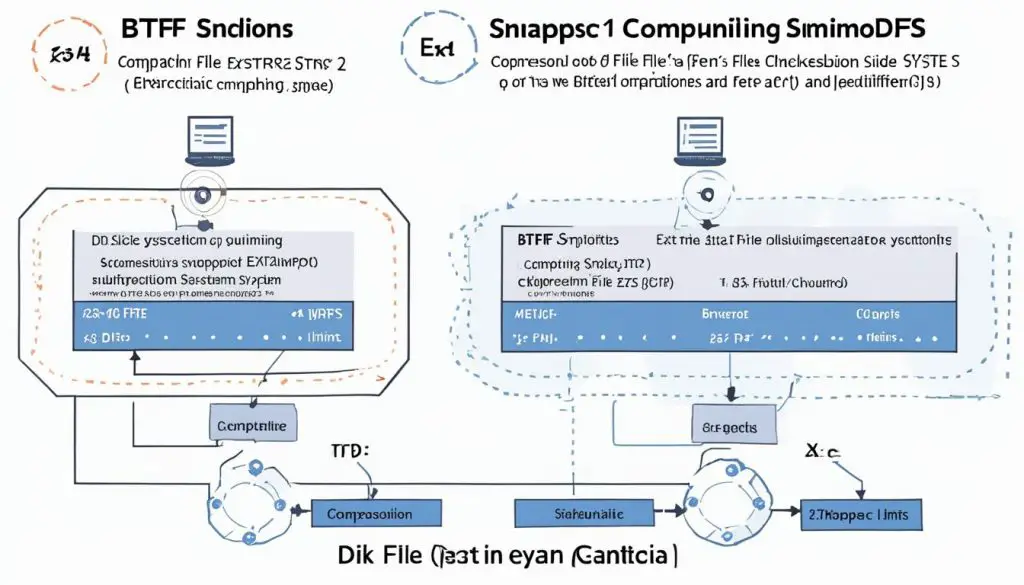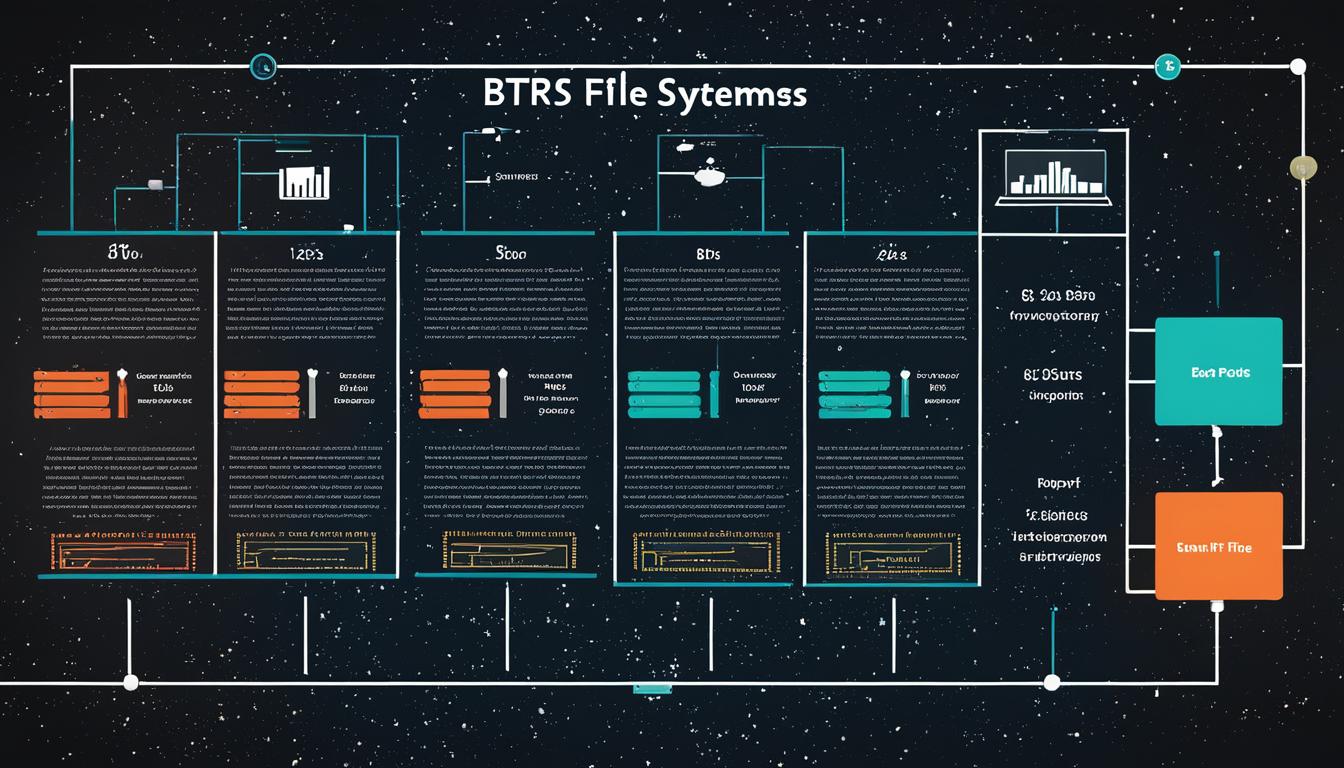EXT4 vs BTRFS: Best Linux File System Compared
When it comes to Linux file systems, two popular options that often come up in discussions are ext4 and btrfs. Both file systems offer different features and capabilities, making them suitable for different use cases. In this article, I will compare the performance, stability, and features of ext4 and btrfs to help you make an informed decision when choosing the best file system for your Linux system.
Key Takeaways:
- Ext4 is a well-established and widely used file system in the Linux ecosystem, offering better scalability, performance, and reliability than its predecessor, ext3.
- Btrfs is an advanced file system that utilizes B-trees as the foundational data structure, offering improved performance, data integrity, scalability, and advanced snapshot capabilities.
- When it comes to performance, ext4 excels in fast file transfers and efficient data allocation, while btrfs provides features like copy-on-write and data compression for enhanced data integrity and storage efficiency.
- Ext4 is known for its stability and reliability, with extensive testing and bug fixes. Btrfs, although still under development, offers features like checksums and snapshot support for enhanced data integrity and recovery options.
- Scalability is another aspect to consider, with ext4 having limitations on maximum file size and partition size, while btrfs offers much higher limits, making it suitable for high-capacity installations.
What is ext4?
Ext4, the fourth Extended File System, is a widely used and well-established file system in the Linux ecosystem. It is the default file system for many Linux distributions and offers better scalability, performance, and reliability than its predecessor, ext3.
Some of the key features of ext4 include:
- Journaling: Ext4 uses journaling, a technique that improves data integrity and recovery in the event of power failures or system crashes.
- Support for large file sizes and file systems: Ext4 has the capability to handle files and file systems of large sizes, making it suitable for modern data storage needs.
- Extents fragmentation reduction: Ext4 reduces fragmentation by using extents, which improves performance by storing large contiguous blocks of data.
- Delayed space allocation: Ext4 employs delayed allocation, a technique that defers block allocation until the data is actually written to disk, leading to improved performance and reduced fragmentation.
With these features, ext4 provides a reliable and efficient foundation for storing and managing data in Linux systems.
What is btrfs?
Btrfs, also known as B-Tree File System, is an advanced Linux file system that utilizes B-trees as the foundational data structure. It offers improved performance, data integrity, scalability, and advanced snapshot capabilities compared to traditional file systems like ext4.
Key features of btrfs include:
- Copy-on-write (COW): Btrfs employs a copy-on-write mechanism, which ensures that data is not overwritten or modified directly. Instead, any changes made to a file or directory are saved as new data, preserving the original information. This COW feature enhances data integrity and reduces the risk of data corruption.
- Data checksums: Btrfs performs data checksums to verify the integrity of stored data. This feature detects any data corruption or errors that may occur during storage or transmission, helping to maintain data reliability and prevent silent data corruption.
- Compression: Btrfs offers built-in data compression, which can reduce the storage footprint and improve overall storage capacity. Compressed data takes up less space, enabling users to store more data efficiently. This feature is particularly useful for scenarios where storage space is limited.
- Support for dynamic inode allocation: Btrfs dynamically allocates inodes, which are data structures that store information about files and directories. This dynamic allocation allows for efficient management of file system resources and enables better scalability, especially when dealing with a large number of files and directories.
Btrfs is designed to address the limitations of traditional file systems and offers several advantages in terms of performance, data integrity, and storage efficiency.
Performance Comparison: ext4 vs btrfs
When it comes to performance, both ext4 and btrfs have their own strengths and considerations. Ext4 is renowned for its fast file transfers and efficient data allocation, making it an excellent choice for users who prioritize speed and responsiveness. On the other hand, btrfs offers unique features like copy-on-write and data compression that can impact performance but bring additional benefits such as enhanced data integrity and storage efficiency.
Ext4’s optimized design allows for quick file transfers and smooth operations, making it ideal for tasks that require rapid data access. Its efficient data allocation reduces fragmentation and improves read and write speeds, resulting in snappy performance.
Btrfs, despite potentially lower performance due to copy-on-write and data compression, brings impressive advantages in terms of data integrity and efficient storage utilization. Copy-on-write ensures data consistency and enables efficient snapshot functionality, allowing users to preserve the state of files at different points in time. Data compression reduces the space occupied by files, providing higher storage capacity and cost savings.
Consider your specific needs and priorities when choosing between ext4 and btrfs. If speed and quick file transfers are essential, ext4 is an excellent choice. However, if features like data integrity, preservation of file snapshots, and efficient storage utilization are key considerations, btrfs offers compelling advantages.
Performance Comparison Table
| Features | ext4 | btrfs |
|---|---|---|
| File Transfer Speed | Fast | Varies, impacted by copy-on-write and compression |
| Data Allocation | Efficient | Efficient with copy-on-write |
| Data Integrity | N/A | Enhanced with copy-on-write and checksums |
| Storage Efficiency | N/A | Improved with data compression |
Note: N/A indicates the feature is not applicable or does not significantly affect the performance of the respective file system.
Quote:
“While ext4 excels in performance and speed, btrfs offers compelling capabilities for maintaining data integrity, preserving file snapshots, and efficient storage utilization.”
Stability and Reliability: ext4 vs btrfs
When it comes to choosing a file system, stability and reliability are crucial factors to consider. Let’s compare the stability and reliability of ext4 and btrfs to help you make an informed decision.
ext4:
Ext4, being a mature file system, has a proven track record of stability and reliability. It has been extensively tested and has undergone numerous bug fixes over the years. As the default file system for many Linux distributions, ext4 has gained trust and widespread adoption in the community.
btrfs:
Btrfs, on the other hand, is still under development and may exhibit some instability issues. However, it offers advanced features like checksums and snapshot support, which greatly enhance data integrity and recovery options. Despite its ongoing development, btrfs has gained popularity for its unique capabilities and the potential it holds for the future of Linux file systems.
“When it comes to stability, ext4 has the advantage of being a mature and extensively tested file system. However, btrfs offers innovative features that can enhance data integrity and recovery.”
Table: Stability and Reliability Comparison
| ext4 | btrfs | |
|---|---|---|
| Stability | Highly stable and reliable | Still under development with some instability issues |
| Trust and Adoption | Widely trusted and adopted | Gaining popularity and future potential |
Despite ext4’s established stability and reliability, btrfs offers unique features that can outweigh the stability concerns for certain use cases. It’s essential to assess your specific requirements and priorities before making a decision.
Choose Stability or Innovative Features?
When deciding between ext4 and btrfs, consider whether stability or innovative features are more important for your particular needs. If you prioritize stability and proven reliability, opting for ext4 is a safe choice. On the other hand, if you value advanced capabilities like checksums and snapshot support, btrfs can provide enhanced data integrity and recovery options.
“The stability of ext4 makes it a reliable choice, while btrfs offers innovative features to enhance your file system.”
Ultimately, the choice between ext4 and btrfs depends on your specific requirements and risk tolerance. If you seek stability and established performance, ext4 should be your go-to option. However, if you’re willing to explore the evolving landscape of file systems and embrace cutting-edge features, btrfs may be the right choice for you.
Scalability: ext4 vs btrfs
Scalability is a crucial consideration, especially for large-scale systems. Let’s examine the scalability of ext4 and btrfs, two popular Linux file systems.
Ext4 Scalability:
Ext4 offers excellent scalability for most desktop and server configurations. It has a maximum file size limit of 16TiB, allowing you to store and manage large files efficiently. Additionally, ext4 supports a maximum partition size of 1 exbibyte, ensuring ample space for your data needs.
Btrfs Scalability:
Btrfs takes scalability to the next level, making it an ideal choice for high-capacity installations. With a staggering maximum file size limit of 16EiB, btrfs can handle enormous amounts of data. Similarly, it supports a maximum partition size of 16EiB, enabling seamless expansion for your storage requirements.
Scalability Comparison:
| Ext4 | Btrfs | |
|---|---|---|
| Maximum File Size | 16TiB | 16EiB |
| Maximum Partition Size | 1 exbibyte | 16EiB |
The table above provides a concise overview of the scalability differences between ext4 and btrfs.
As you can see, btrfs surpasses ext4 in terms of scalability, offering significantly larger maximum file and partition sizes. If you require a file system that can handle massive amounts of data and provide ample room for growth, btrfs is the recommended choice.
Features Comparison: ext4 vs btrfs
When comparing the features of ext4 and btrfs, it becomes apparent that btrfs offers several advantages over ext4. One of the notable features of btrfs is its support for data deduplication, which allows for efficient storage and optimization of disk space. This feature is particularly beneficial for systems that handle large amounts of data and need to minimize storage requirements.
Another significant advantage of btrfs is its support for file system compression. By compressing files on-the-fly, btrfs can reduce the amount of storage space required, allowing for better utilization of resources and improved performance.
Btrfs also offers snapshot capabilities, allowing users to create point-in-time copies of their file systems. This feature is invaluable in scenarios where data integrity and backup capabilities are paramount, as it simplifies the process of creating backups and provides a reliable means of reverting to previous states.
The dynamic inode allocation feature offered by btrfs is another noteworthy advantage. With dynamic inode allocation, btrfs can efficiently manage and allocate inodes as needed, ensuring optimal resource utilization and flexibility.
On the other hand, ext4, while lacking some of these advanced features, remains a reliable and widely supported file system. It offers good performance and simplicity, making it an attractive choice for users who prioritize stability and ease of use.
Now, let’s take a closer look at the comparison between the features of ext4 and btrfs in a side-by-side fashion:
| Feature | ext4 | btrfs |
|---|---|---|
| Data Deduplication | No | Yes |
| File System Compression | No | Yes |
| Snapshots | No | Yes |
| Dynamic Inode Allocation | No | Yes |
| Performance | Good | Varies based on features used |
| Stability | High | Improving |
| Support | Widely supported | Developing support |
As shown in the table above, btrfs surpasses ext4 in terms of its advanced features and capabilities. However, it’s important to consider the trade-offs between these features and the overall system requirements when making a decision.

It’s clear that both ext4 and btrfs have their strengths and weaknesses when it comes to features. The choice between the two ultimately depends on your specific needs and priorities. If storage efficiency, data integrity, and backup capabilities are important to you, btrfs may be the more suitable option. However, if stability and simplicity are your primary concerns, ext4 remains a reliable choice.
Advantages of ext4 over btrfs
Ext4, the mature and widely supported Linux file system, offers several advantages over btrfs. It has undergone extensive testing and bug fixes, making it a reliable choice for users. With its good performance, reliability, and simplicity, ext4 is well-suited for most Linux environments.
One of the key advantages of ext4 is its faster file transfer speed compared to btrfs. This makes it an ideal choice for users who prioritize quick and efficient data transfers. Whether you’re working with large files or transferring data between different systems, ext4’s faster file transfer speed can save you valuable time.
Additionally, ext4’s simplicity is another noteworthy advantage. It is easy to set up and use, making it accessible even to less experienced users. With a straightforward structure and familiar functionality, ext4 simplifies the management and maintenance of your file system.
| Advantages of ext4 | |
|---|---|
| Faster file transfer speed | Ext4 offers quicker data transfers compared to btrfs, saving time and improving workflow efficiency. |
| Reliability | Ext4 has a proven track record of stability and is widely supported in the Linux community. |
| Simplicity | Ext4 is easy to set up and use, making it accessible for users of all experience levels. |
In conclusion, ext4 provides significant advantages over btrfs, including faster file transfer speed, reliability, and simplicity. These features make ext4 a solid choice for most users, particularly those who prioritize speed and ease of use.
Advantages of btrfs over ext4
When comparing btrfs and ext4, it becomes evident that btrfs offers several advantages over ext4. Here are some key reasons why btrfs stands out:
- Data integrity: Btrfs utilizes checksums to ensure the integrity of data stored in the file system. This means that if any data corruption occurs, btrfs can automatically detect and repair it, helping to maintain data accuracy.
- Improved storage capacity: Btrfs supports file system compression, which allows for efficient storage utilization. By compressing data on the file system level, btrfs can significantly increase storage capacity without sacrificing performance.
- Enhanced backup capabilities: Btrfs offers features like data deduplication and snapshot support, which are valuable for creating reliable and efficient backups. Data deduplication eliminates duplicate copies of data, reducing storage requirements. Snapshot support enables the creation of point-in-time copies of the file system, making it easier to restore previous versions of files or roll back changes.
- Higher limits: Btrfs has a higher maximum file size and partition size limit compared to ext4. This makes it a better choice for high-capacity installations that require handling large amounts of data.
Overall, btrfs provides enhanced data integrity, improved storage capacity, advanced backup capabilities, and higher scalability compared to ext4.
Conclusion
In conclusion, both ext4 and btrfs are viable options for Linux file systems, each offering their own set of advantages. Ext4 is a stable and reliable choice that provides good performance and simplicity. It has been extensively tested and offers a mature solution for users who prioritize stability and speed. On the other hand, btrfs offers advanced features like checksums, compression, and snapshot support, making it a suitable option for users who require enhanced data integrity and backup capabilities.
The decision between ext4 and btrfs ultimately depends on your specific needs and priorities. If you value stability, performance, and simplicity, ext4 is a safe choice that continues to be widely used and supported. However, if you require advanced features and scalability, btrfs can provide a more comprehensive solution with its support for checksums, compression, and dynamic inode allocation. Additionally, btrfs’s higher maximum file size and partition size limit make it a better choice for high-capacity installations.
Ultimately, the choice between ext4 and btrfs comes down to understanding your requirements and evaluating which features align with your needs. Whether you prioritize stability and speed or advanced features and scalability, both ext4 and btrfs can be excellent choices for your Linux file system needs.
FAQ
What are the advantages of ext4 over btrfs?
Ext4 is a mature and widely supported file system that offers good performance, reliability, and simplicity. It has undergone extensive testing and bug fixes, making it a stable choice. Ext4 also transfers files faster than btrfs, making it a good option for users who prioritize speed.
What are the advantages of btrfs over ext4?
Btrfs offers several advantages over ext4, including data integrity through the use of checksums, file system compression for improved storage capacity, and features like data deduplication and snapshot support for enhanced backup capabilities. Btrfs also has a higher maximum file size and partition size limit, making it a better choice for high-capacity installations.
Which file system should I choose, ext4 or btrfs?
The choice between ext4 and btrfs depends on your specific needs and priorities. If you value stability and speed, ext4 is a safe choice. However, if you require advanced features, scalability, and data integrity, btrfs can provide a more comprehensive solution.
What is ext4?
Ext4, the fourth Extended File System, is a widely used and well-established file system in the Linux ecosystem. It offers better scalability, performance, and reliability than its predecessor, ext3. Key features of ext4 include journaling, support for large file sizes and file systems, extents fragmentation reduction, and delayed space allocation.
What is btrfs?
Btrfs, also known as B-Tree File System, is an advanced Linux file system that utilizes B-trees as the foundational data structure. It offers improved performance, data integrity, scalability, and advanced snapshot capabilities compared to traditional file systems like ext4. Key features of btrfs include copy-on-write, data checksums, compression, and support for dynamic inode allocation.
How do ext4 and btrfs compare in terms of performance?
Ext4 is known for its fast file transfers and efficient data allocation, making it a good choice for users who prioritize speed. On the other hand, btrfs offers features like copy-on-write and data compression, which can impact performance but provide benefits in terms of data integrity and storage efficiency.
Which file system, ext4 or btrfs, is more stable and reliable?
Ext4 is a stable and reliable option that has been in use for a long time. It has undergone extensive testing and bug fixes, making it a trusted choice. Btrfs is still under development and may have some instability issues, but it offers features like checksums and snapshot support that enhance data integrity and recovery options.
How do ext4 and btrfs compare in terms of scalability?
Ext4 has a maximum file size and partition size limit of 16TiB and 1 exbibyte, respectively, which is generally sufficient for most desktop and server configurations. Btrfs, on the other hand, offers much higher limits of 16EiB for both file size and partition size, making it a better choice for high-capacity installations.
What are the key features of ext4?
Ext4 offers key features such as journaling, support for large file sizes and file systems, extents fragmentation reduction, and delayed space allocation. These features contribute to its scalability, performance, and reliability.
What are the key features of btrfs?
Btrfs offers key features such as copy-on-write, data checksums, compression, and support for dynamic inode allocation. These features enhance data integrity, storage efficiency, and backup capabilities.
Source Links
- https://www.cbtnuggets.com/blog/technology/system-admin/linux-file-systems-ext4-vs-btrfs-vs-zfs
- https://www.geeksforgeeks.org/difference-between-ext4-vs-btrfs-filesystems-in-linux/
- https://forum.endeavouros.com/t/ext4-btrfs-or-other-what-difference-and-which-is-the-best-file-system/43266
- About the Author
- Latest Posts
Janina is a technical editor at Text-Center.com and loves to write about computer technology and latest trends in information technology. She also works for Biteno.com.






